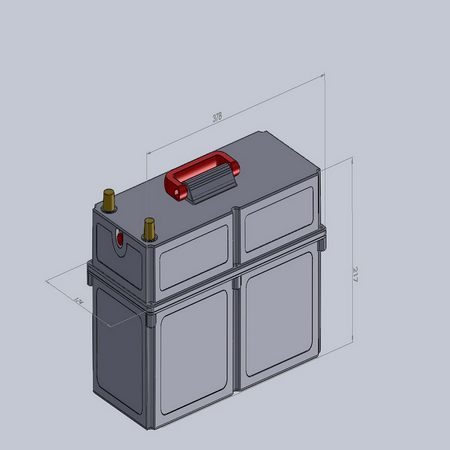Generator Batteries
| Item No.: | JBJPBA-2456 |

This specification describes the structural, performance, testing method, warning and caution of the Lithium Iron Phosphate battery.
2. Structural Design
2.1 Model:24V/56AH
2.2 Dimension of Battery Pack(with case):W*L*H 180*685*200mm
2.3 Cell: LFP1780123-8
2.4 Assembly style:8S7P
Explanation:
A:Battery pack will be assembled by 8S7P of cell-LFP32501300
B:Ensure that the battery pack can work using 10mm2 copper pillar.
3. Basic Performance(Battery Pack)
| NO. | Item | Specification | Remark |
| 1 | Nominal Capacity | 56AH | 0.2C,CC/CV(constant current)discharge to 16V cut off, at 23±3℃ |
| 2 | Nominal Voltage | 27.2V | Standard Output Nominal Voltage |
| 3 | Standard Charging Current | 10A | 0 ℃ ~45 ℃ 0.2C CC(constant current)charge to 28V,then CV(constant voltage 29.2V)charge till charge current≤0.01C |
| 4 | Max.Charging Current | 50A(1C) | At 0℃~45℃,Max 1C CC(constant current) charge to 28V |
| 5 | Charge Ending Voltage | 29.2 V | Best for 0.2C CC/CV 29.2V,0.01C cut off. |
| 6 | Standard Discharging Current | 500A(10C) | 10C CC(constant current)discharge to 16V |
| 7 | Max.Discharging Current | 1000A(20C) | At 23 ℃ ,The battery working discharge current keeps 1000A for 10s |
| 8 | Temperature while charging | 0℃~45℃ | Battery charging process, battery and ambient temperature does not exceed 45℃ |
| 9 | Temperature while discharging | -20℃~65℃ | The specified temperature range, the battery work normally within the framework of capacity loss in the error |
| 10 | Battery Weight | <20Kg | Include wires and packaging material |
| 11 | Product Impedance | ≤50mΩ | AC Impedance |
4. Performance Data
4.1 Battery Pack Performance
| NO. | Item | Criterion | Test Method | |
| 1 | C-rate characteristics | 0.2C | 100 | Test Temperature:23±3°C Charge:0.2C,CC/CV,29.2V, current≤0.01C cut-off Discharge:0.2C/2C,CC,16V cut off |
| 2C | ≥95 | |||
| 2 | Temperature Dependence of Capacity | 60℃ | ≥95 | Charge:0.2C,CC/CV,29.2V, current≤0.01C cut-off, at 23±3°C Discharge: At setting temperature 0.5C,CC,16V cut-off (Interval for temperature change is 2 hours) |
| 45℃ | ≥95 | |||
| 23℃ | 100 | |||
| 0℃ | ≥65 | |||
| -10℃ | ≥50 | |||
| 3 | Cycle Life Characteristics | 1500~200 cycles | Charge:0.2C CC/CV,29.2V,current≤0.01C cut-off Discharge:0.5C CC 16V cut-off When the discharge capacity reduced to 80 of initial capacity, Stop testing. | |
| 4 | Storage Characteristics (Recovery Capacity) | 23℃ | ≥95 | On a storage, Cell state is 60 ~75 charge |
| 45℃ | ≥90 | |||
| 60℃ | ≥90 | |||
| NO. | Item | Criterion | Test Method |
| 1 | Constant temperature and constant humidity test | No explosion,no fire, no leakage. Discharging capacity is not less than 60 initial capacity | After Standard Charging, test condition: Temperature: 40±5°C Relative Humidity:90~95RH Storage Tine:48Hours Then return to room temperature for 2 hours, Then 1C discharge to ending voltage |
| 2 | Vibration Test | No explosion,no fire,no leakage | After standard charging, fixed the cell to vibrationtable, then subjected to vibration test for 30 minutes per axis of XYZ axes Frequency rate:1oct/min Vibration frequency:10Hz-30Hz Excursion(single amplitude):0.38mm Vibration frequency:30Hz-55Hz Excursion(single amplitude):0.19mm |
| 3 | Low-pressure | No explosion, no fire,no leakage | 23±3°C .Stalled in really empty, gradually reduce the internal pressure ≤ 11.6 kPa (simulated altitude 15240m) and maintain 6 hours. |
| 4 | Drop Test | No explosion,no fire,no leakage | Drop the battery in the shipment condition from 1m height onto 5cm thicker concrete with p-tile on it 3 times each of X,Y and Z directions at 23±3°C. |
4.3 Safety Performance
| NO. | Item | Criterion | Test Method |
| 1 | Overcharge Test | No explosion, no fire. | 3C,CC/CV,10V at 23±3°C;When the capacity reach 2.5C or time reach 60 minutes, end test. |
| 2 | Over discharge Test | No explosion, no fire. | After discharged to the cut-off voltage. The battery shall be subjected to a short-circuit condition with a load of resistance less than 30Ω for 24 hour. |
| 3 | Heating Test | No explosion, no fire. | A battery is to be heated in a gravity in a gravity convection or circulating air oven. The temperature of the oven is to be raised at a rate of 5±2°C/min to a temperature of 130±2°C at which temperature the oven is to remain for 30 minutes before the test is discontinued. |
| 4 | High Temp Test | No explosion,no fire,Recovery Capacity ≥ 80 | After standard charge ,leaving the battery at 85°C for 4 hours. |
| 5 | Short-circuit Test | No explosion, no fire. | After standard charge, the battery shall be subjected to a short-circuit condition with a wire of resistance less than 100mΩ for 1 hour. |
5. PCM Specification
5.1 Electrical Characteristics(Normal temperature, Relative
| Item | Test standard value |
| Over charge Protection voltage | 3.90±0.025V/ |
| Over discharge Protection voltage | No |
| Over current Protection current | No over-current protection |
| Over temperature protection | Disconnect the load |
| Short Protection release condition | Disconnect the load |
5.2 Circuit Diagram

5.3 Communication interface: RS232 switch USB, available through the software to monitor battery status
6. Storage and Shipment Requirement
| Item | Requirement | ||
| Storage temperature | Short period less than 1 month | -10°C~+45°C | |
| Long period less than 6 month | -10°C~+35°C | ||
| Humidity | <75 RH | ||
| Charged | About 50~75 state 50~75 | charged | |
 English
English
 Русско
Русско Deutsch
Deutsch Español
Español Português
Português Français
Français Türk
Türk Italiano
Italiano Nederlands
Nederlands हिन्दी
हिन्दी Bahasa Indonesia
Bahasa Indonesia
